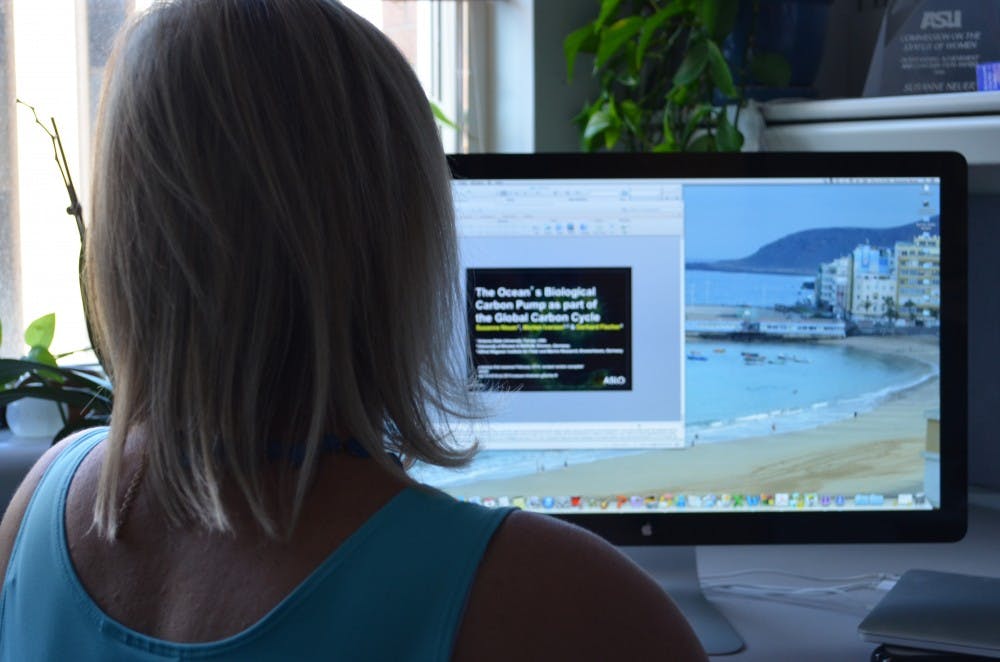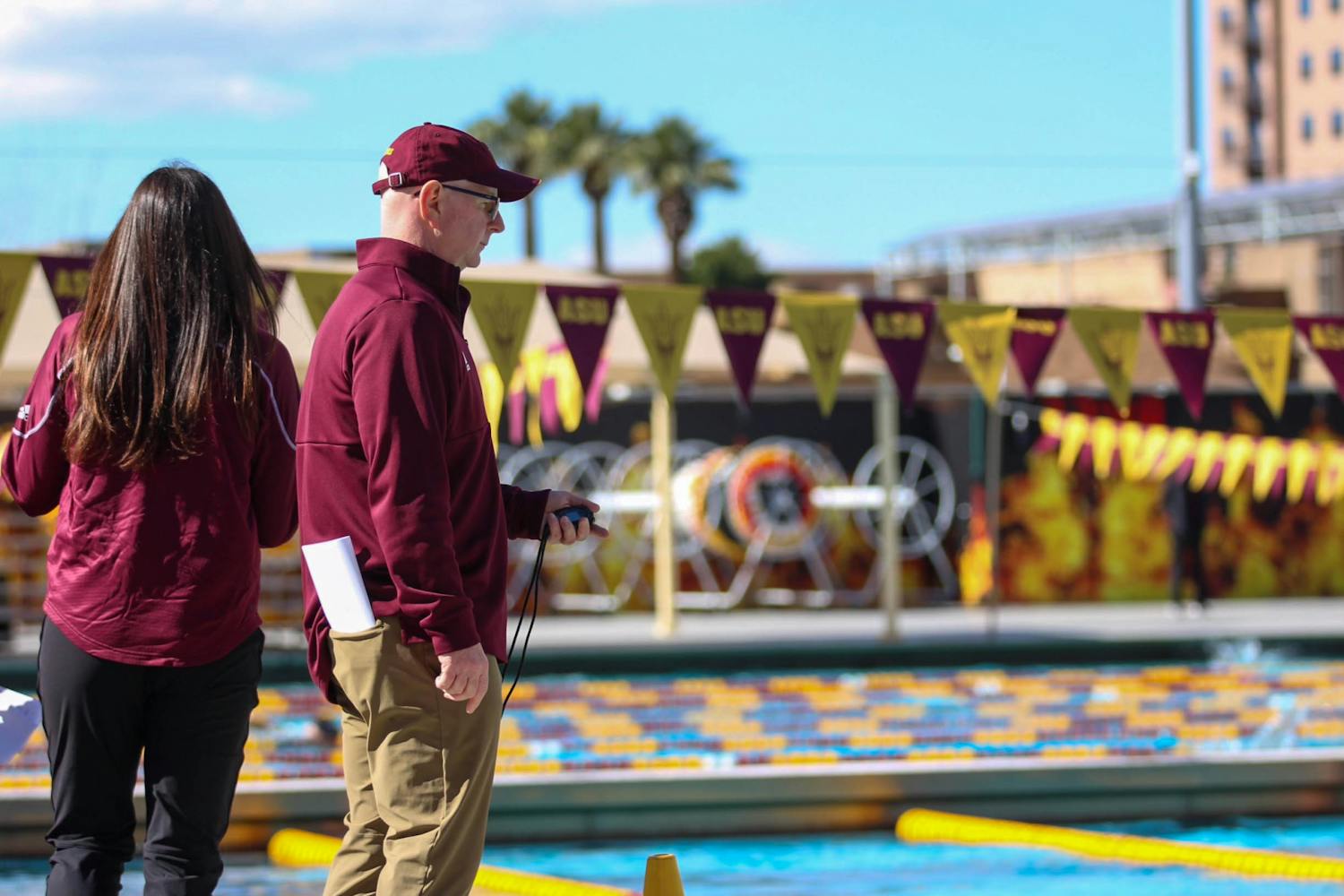 Professor Susanne Neuer out on the Arctic field. Photo Courtesy of Professor Susanne Neuer
Professor Susanne Neuer out on the Arctic field. Photo Courtesy of Professor Susanne NeuerIt’s 1975. The 9-year-old slips her feet into the small flippers and secures a face mask over her eyes and nose, tangling her blond hair in its straps. She clips the snorkel to the side of the mask so the mouthpiece falls just below her chin.
Susanne Neuer has never been around salt water. She lives in the Rhine Valley in southern Germany, with freshwater lakes and rivers flowing through the rural landscape. The child’s dark-blue eyes glow in anticipation. Her parents and younger brother don their snorkeling gear and they all wade awkwardly into the Mediterranean Sea.
The warm waves off the coast of the Balearic Islands near Spain crash beneath rocky cliffs and hide an unknown world beneath their ebb and flow. Neuer bites down on her mouthpiece and glides on her belly atop the surface of the ocean. She puts her head below the surface.
She opens her eyes and takes a deep breath.
At first, there is only the shell-speckled sand. Then underwater grass, algae and seaweed float into her goggled vision. She kicks her legs and parts her arms in a breast stroke, sometimes stopping to float and take in the watery scene. Fish swim around a coral reef, appearing to play “hide and go seek."
In this moment, Neuer’s fate is sealed. She cannot escape her fascination with the ocean, a fascination that will lead her, many years later, into climate-change research and a professorship in oceanography at Arizona State University.
With every family vacation to the Mediterranean, Neuer strengthens her eagerness to learn about life in the sea.
When she is 13, she wants only one thing in the entire world: a microscope.
She earns three deutsche marks an hour (about $2, today) at a local floral shop in the town near her rural home.
She saves enough to purchase the 300-deutshe mark microscope with the real optics and high resolution to help her study tiny microorganisms swimming around in the Rhine River on the Germany-Switzerland border. She walks into the optics store to buy the microscope of her dreams. She is overcome by her feelings of excitement and accomplishment.
Neuer knows she’s different from other kids. She doesn’t want bicycles, board games or makeup.
She is a geek who hangs out with geeks.
As she grows up, instead of going out dancing with friends at discos, she collects river water samples and analyzes data— content in her solitary hobby.
But she dreams of teaching.
Her mother is a homemaker and her father works as Police Director with the water police to regulate traffic and environmental work on the rivers.
Neither parent has a degree, although both love learning.
Her mother is the “driving force,” taking the family on hikes and pointing out different plants and animals along the way. Both her mother and father continue their own educations via evening schooling and are extremely supportive. They, too, want their daughter to teach.
She dreams of becoming a university professor who teaches oceanography. At the time, in Germany, academia is a male-dominated field and female professors are rare. People tell her a woman cannot have a career and children. She wonders if she will have to choose.
She receives her degree in biology from the University of Heidelberg and the University of Kiel. All of her professors are men.
In 1988, on a Fulbright-ITT fellowship, she travels to the United States to pursue a Master of Science degree in biological oceanography from the University of Washington in Seattle.
Here, at an orientation for the fellowship program, she meets her future husband, microbiologist Ferran Garcia-Pichel. She graduates from the University of Washington and obtains her Ph.D. in ocean and atmospheric sciences from Oregon State University. Next, the couple packs up their newborn daughter, Marlene Garcia-Neuer, and heads back to Europe to be near family.
But Garcia-Pichel is offered a research faculty position at Arizona State University, and the family moves to the Phoenix area. Soon Neuer is teaching oceanography at the university as well.
She grows a garden — searching for another connection to the natural sciences.
But she misses the ocean.
An oceanographer in the desert
 Professor Neuer's dreams of becoming a university oceanography professor has come true at ASU. Photo by Luu Nguyen
Professor Neuer's dreams of becoming a university oceanography professor has come true at ASU. Photo by Luu NguyenToday, professor Susanne Neuer, 50, is an oceanographer at ASU.
Now she’s focusing her research on climate change. Through funding from National Science Foundation (NSF) and the School of Life Sciences at ASU, Neuer hopes to gain an increased understanding of the role and fate of oceanic phytoplankton in a changing climate.
Ninety-seven percent of climate scientists agree the world is warming, and that humans have a hand in it, according to the National Aeronautics and Space Administration.
The level of carbon dioxide in the atmosphere, Earth’s temperature and sea levels all continue to rise at unprecedented rates as humans continue to burn fossil fuels and emit carbon dioxide, many scientists say. As climate change intensifies, scientists look for a way to control carbon dioxide emissions.
The oceans may be part of the answer.
Oceanographers and marine scientists now focus their research on ways to understand how a changing climate affects marine ecosystems that help to mediate climate change.
Associate professor Hilairy Hartnett also teaches courses in oceanography at ASU.
“The biggest question in earth and climate science right now is [about] carbon dioxide,” Hartnett says. “And the oceans are a big component… because it turns out a lot of it is soaked up by the oceans.”
“There’s all kinds of disagreement on who is responsible for all this carbon and how much of it is natural and how much of it is put there by us,” Arizona State climatologist Nancy Selover, an appointee of Gov. Jan Brewer, says. But she emphasizes that “efforts to remove carbon need to be investigated more.”
Neuer believes phytoplankton may hold the answer.
 Neuer believes phytoplankton may hold the answer. Photo by Luu Nguyen
Neuer believes phytoplankton may hold the answer. Photo by Luu NguyenPhytoplankton are microscopic, single-celled algae that dwell near the surface of the water. These tiny organisms take up CO2 during the process of photosynthesis and release oxygen, like plants on land. Indeed, these tiny organisms are responsible for half of the photosynthesis on Earth, which also means they are responsible for half of the CO2 consumption and half of the oxygen production, according to Neuer.
“I didn’t know all of that when I started as a teenager to study it, but it became, early on, very clear,” Neuer says, in her lilting German accent. “They have an incredible importance beyond just being curious and beautiful and diverse and a whole world in themselves. We couldn’t be around without them.”
Neuer recently completed research on phytoplankton ecology in the Sargasso Sea with a team of undergraduate and graduate students who assist in collecting and analyzing data. In the warmth of the subtropical waters, the team studied the process of photosynthesis and the way these surface-dwellers form particles of organic biomass that sink to the sea floor, which helps to remove CO2 captured by photosynthesis and ultimately feeds animals on the sea-floor.
The phytoplankton is essential in the survival of life on earth. Because of this, Neuer hopes that microscopic algae will be able to maintain this process of photosynthesis and formation of sinking particles. When it comes to global warming, several ecosystems are threatened by changes in the climate. But now that there is a better understanding of the phytoplankton’s part in helping regulate the carbon dioxide content of the atmosphere, it has become a precious group of microorganisms to those in on the secret.
In 2008, Neuer received a NSF-Biological Oceanography grant to study both the surface phytoplankton and the microscopic phytoplankton communities that make up sinking particles of organic carbon from the surface to the deep ocean. These organic particles are made up of carbon taken from the surface of the ocean. Neuer’s study confirmed her hypothesis that phytoplankton are a large part of the transfer of carbon out of the atmosphere.
Currently, Neuer has another NSF-Biological Oceanography grant to study the connection between these surface dwelling phytoplankton and the phytoplankton in the sinking particles. Research has also shown that the phytoplankton are crucial to a food chain that extends to the largest whales in the ocean. Neuer says that the “marine phytoplankton are the basis of the food web that ultimately leads to all those charismatic animals that we associate with ocean life.” She says she hopes to characterize these sinking particles for their role in the export of carbon dioxide from the surface to the deep ocean.
She is also pursuing a research project in the Arctic Ocean off of Barrow, Alas. Student researchers are analyzing both ocean and ice samples from Barrow to study how phytoplankton function beneath the frozen surface of the Arctic Ocean. Preliminary analysis has shown that the phytoplankton living in small brine channels in the ice are able to use their location to access the surface for both carbon and sunlight for photosynthesis.
But Neuer wants to know: Is there something that may be threatening the survival of phytoplankton?
On her research website, neuer.lab.asu.edu, she writes: “Microorganisms living in sea ice affect carbon and nutrient cycling in polar seas, but their susceptibility to the changing environmental conditions of polar regions is not well understood.” She goes on to say that the phytoplankton has adapted to its brine-channel habitat. But with climate change, Arctic ice continues to melt — and Neuer wants to know whether the phytoplankton are in danger.
How long will the tiny algae be able to survive?
A passion for the sea
 Professor Neuer hard at work discovering new research in the field of oceanography. Photo by Luu Nguyen.
Professor Neuer hard at work discovering new research in the field of oceanography. Photo by Luu Nguyen.A few small posters are taped to the simple wooden door of Neuer’s ASU office. One shows a starfish under a clouded sky that merges with the ocean. It says: “At home in the ocean.”
Her office, on the fourth floor of the Life Sciences E building, is dimly blue compared to the glaring sun outside. It is small, homey. A large desk fills most of the room from the corner beside the window. A plastic ivy plant snakes along the windowsill and around the fish sculptures that swim beside piles of books and papers. A round table sits to the right of the door beside a bookcase brimming with books on plankton, biology, microbiology and ocean chemistry.
Neuer is 5 feet 3 inches tall and sturdily built from weekends spent hiking the desert with her husband. She wears her shoulder-length blonde hair loose around her square face. She wears a white tank top with a skinny teal scarf that matches her long teal skirt. The lines around her eyes crinkle with her open smile. Her arms rest on the table as she occasionally holds up a finger to accentuate a critical point in her talk. She laughs at a few memories but comes back to the science with a serious tone and a focused expression.
She points to a map on one wall to show the location of the Sargasso Sea. She rises out of her chair to point to another map, this one a collection of photos from a NASA satellite that shows the amount of algae in the ocean across the globe. She talks about her research on the food web, the phytoplankton and the possibilities that exist within the liquid covering 70 percent of the earth’s surface.
“You’re getting a free oceanography lecture right now,” she says with a hearty laugh. She’s gotten mixed reviews on the popular website, Rate My Professor. Positive reviews report her as helpful and nice, while negative reviews report Neuer as “standoffish and edgy.” Neuer views teaching as an important part of her work and says she has received good teaching evaluations from her students.
She says the largest obstacle has been finding collaborators and colleagues with similar interests at ASU. Because of the desert location, she says that most researchers focus on desert biology and natural sciences. Neuer has broadened her research to include topics relating to local lakes and reservoirs in order to bridge the gap.
She shares a passionate interest in microbiology with her daughter and husband. Garcia-Pichel is a fellow microbial ecologist and the Dean of Natural Sciences at ASU. Marlene, their daughter, is now 21 and hopes to become a doctor specializing in immunology.
Neuer says the family often discusses new scientific findings or articles written in Science and Nature Magazine.
“If there’s anything published in them on oceanography or any microbial-ecology related thing, those are common things we would discuss at home,” she says.
Neuer finds time to work closely with the Central Arizona chapter of the Association for Women in Science. She was elected to the national executive board as a president in 2008, and still works to promote women working and researching in science.
Following the example of her parents, Neuer says there is always more to learn and one is never done learning.
She dreams of making “big discoveries,” but says her “internal hope” is to keep growing as both a scientist and a person.
“We are such a global environment,” Neuer says. “We’re a planet where everything is interconnected and people need to know about that.”
Reach the writer at mamccrea@asu.edu or via Twitter @mmccreary6.




